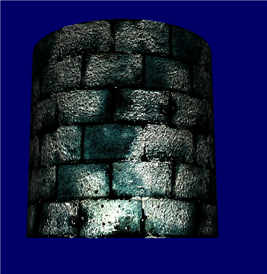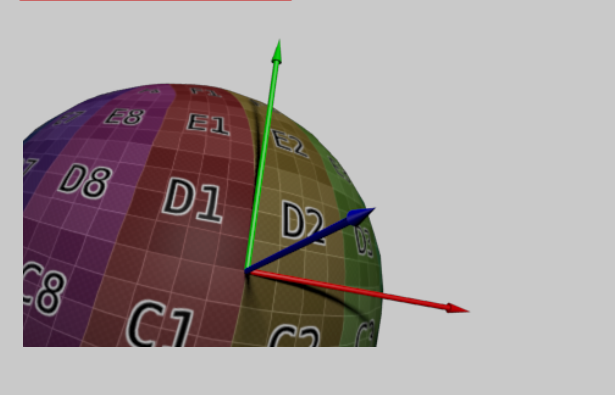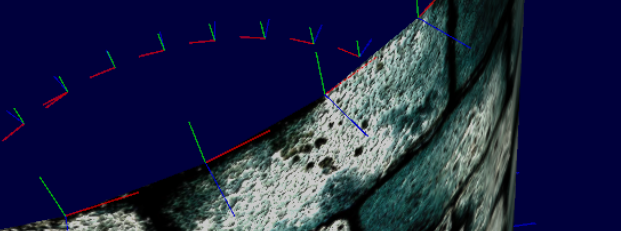标签:upd uil turn read zed 技巧 sim off arrays
法向量纹理,让纹理显示的更逼真?
http://www.opengl-tutorial.org/uncategorized/2017/06/07/website-update/
http://www.opengl-tutorial.org/cn/intermediate-tutorials/tutorial-13-normal-mapping/ (还有中文版在一直没有察觉)

需要两个法向量,蓝色是Normal法向量,红色是T向量简称切平面向量,绿色B向量,也是切平面向量且B 和 N cross T 同向

作者对于镜面纹理使用了一种技巧 使用颜色“vec3(0.3,0.3,0.3)” 灰色作为镜面颜色。
//glfwWindowHint(GLFW_OPENGL_PROFILE, GLFW_OPENGL_COMPAT_PROFILE); // So that glBegin/glVertex/glEnd work 作者在这里放上了调试接口
glMatrixMode(GL_PROJECTION);
glLoadMatrixf((const GLfloat*)&ProjectionMatrix[0]);
glMatrixMode(GL_MODELVIEW);
glm::mat4 MV = ViewMatrix * ModelMatrix;
glLoadMatrixf((const GLfloat*)&MV[0]);

通过观察顶点的NTB向量的朝向debug。
color.xyz = LightDirection_tangentspace;
// Include standard headers
#include <stdio.h>
#include <stdlib.h>
#include <vector>
// Include GLEW
#include <GL/glew.h>
// Include GLFW
#include <GLFW/glfw3.h>
GLFWwindow* window;
// Include GLM
#include <glm/glm.hpp>
#include <glm/gtc/matrix_transform.hpp>
using namespace glm;
#include <common/shader.hpp>
#include <common/texture.hpp>
#include <common/controls.hpp>
#include <common/objloader.hpp>
#include <common/vboindexer.hpp>
#include <common/tangentspace.hpp>
int main( void )
{
// Initialise GLFW
if( !glfwInit() )
{
fprintf( stderr, "Failed to initialize GLFW\n" );
getchar();
return -1;
}
glfwWindowHint(GLFW_SAMPLES, 1);
glfwWindowHint(GLFW_CONTEXT_VERSION_MAJOR, 3);
glfwWindowHint(GLFW_CONTEXT_VERSION_MINOR, 3);
glfwWindowHint(GLFW_OPENGL_FORWARD_COMPAT, GL_TRUE); // To make MacOS happy; should not be needed
glfwWindowHint(GLFW_OPENGL_PROFILE, GLFW_OPENGL_CORE_PROFILE);
//glfwWindowHint(GLFW_OPENGL_PROFILE, GLFW_OPENGL_COMPAT_PROFILE); // So that glBegin/glVertex/glEnd work
// Open a window and create its OpenGL context
window = glfwCreateWindow( 1024, 768, "Tutorial 13 - Normal Mapping", NULL, NULL);
if( window == NULL ){
fprintf( stderr, "Failed to open GLFW window. If you have an Intel GPU, they are not 3.3 compatible. Try the 2.1 version of the tutorials.\n" );
getchar();
glfwTerminate();
return -1;
}
glfwMakeContextCurrent(window);
// Initialize GLEW
glewExperimental = true; // Needed for core profile
if (glewInit() != GLEW_OK) {
fprintf(stderr, "Failed to initialize GLEW\n");
getchar();
glfwTerminate();
return -1;
}
// Ensure we can capture the escape key being pressed below
glfwSetInputMode(window, GLFW_STICKY_KEYS, GL_TRUE);
// Hide the mouse and enable unlimited mouvement
glfwSetInputMode(window, GLFW_CURSOR, GLFW_CURSOR_DISABLED);
// Set the mouse at the center of the screen
glfwPollEvents();
glfwSetCursorPos(window, 1024/2, 768/2);
// Dark blue background
glClearColor(0.0f, 0.0f, 0.4f, 0.0f);
// Enable depth test
glEnable(GL_DEPTH_TEST);
// Accept fragment if it closer to the camera than the former one
glDepthFunc(GL_LESS);
// Cull triangles which normal is not towards the camera
glEnable(GL_CULL_FACE);
GLuint VertexArrayID;
glGenVertexArrays(1, &VertexArrayID);
glBindVertexArray(VertexArrayID);
// Create and compile our GLSL program from the shaders
GLuint programID = LoadShaders( "NormalMapping.vertexshader", "NormalMapping.fragmentshader" );
// Get a handle for our "MVP" uniform
GLuint MatrixID = glGetUniformLocation(programID, "MVP");
GLuint ViewMatrixID = glGetUniformLocation(programID, "V");
GLuint ModelMatrixID = glGetUniformLocation(programID, "M");
GLuint ModelView3x3MatrixID = glGetUniformLocation(programID, "MV3x3");
// Load the texture
GLuint DiffuseTexture = loadDDS("diffuse.DDS");
GLuint NormalTexture = loadBMP_custom("normal.bmp");
GLuint SpecularTexture = loadDDS("specular.DDS");
// Get a handle for our "myTextureSampler" uniform
GLuint DiffuseTextureID = glGetUniformLocation(programID, "DiffuseTextureSampler");
GLuint NormalTextureID = glGetUniformLocation(programID, "NormalTextureSampler");
GLuint SpecularTextureID = glGetUniformLocation(programID, "SpecularTextureSampler");
// Read our .obj file
std::vector<glm::vec3> vertices;
std::vector<glm::vec2> uvs;
std::vector<glm::vec3> normals;
bool res = loadOBJ("cylinder.obj", vertices, uvs, normals);
std::vector<glm::vec3> tangents;
std::vector<glm::vec3> bitangents;
computeTangentBasis(
vertices, uvs, normals, // input
tangents, bitangents // output
);
std::vector<unsigned short> indices;
std::vector<glm::vec3> indexed_vertices;
std::vector<glm::vec2> indexed_uvs;
std::vector<glm::vec3> indexed_normals;
std::vector<glm::vec3> indexed_tangents;
std::vector<glm::vec3> indexed_bitangents;
indexVBO_TBN(
vertices, uvs, normals, tangents, bitangents,
indices, indexed_vertices, indexed_uvs, indexed_normals, indexed_tangents, indexed_bitangents
);
// Load it into a VBO
GLuint vertexbuffer;
glGenBuffers(1, &vertexbuffer);
glBindBuffer(GL_ARRAY_BUFFER, vertexbuffer);
glBufferData(GL_ARRAY_BUFFER, indexed_vertices.size() * sizeof(glm::vec3), &indexed_vertices[0], GL_STATIC_DRAW);
GLuint uvbuffer;
glGenBuffers(1, &uvbuffer);
glBindBuffer(GL_ARRAY_BUFFER, uvbuffer);
glBufferData(GL_ARRAY_BUFFER, indexed_uvs.size() * sizeof(glm::vec2), &indexed_uvs[0], GL_STATIC_DRAW);
GLuint normalbuffer;
glGenBuffers(1, &normalbuffer);
glBindBuffer(GL_ARRAY_BUFFER, normalbuffer);
glBufferData(GL_ARRAY_BUFFER, indexed_normals.size() * sizeof(glm::vec3), &indexed_normals[0], GL_STATIC_DRAW);
GLuint tangentbuffer;
glGenBuffers(1, &tangentbuffer);
glBindBuffer(GL_ARRAY_BUFFER, tangentbuffer);
glBufferData(GL_ARRAY_BUFFER, indexed_tangents.size() * sizeof(glm::vec3), &indexed_tangents[0], GL_STATIC_DRAW);
GLuint bitangentbuffer;
glGenBuffers(1, &bitangentbuffer);
glBindBuffer(GL_ARRAY_BUFFER, bitangentbuffer);
glBufferData(GL_ARRAY_BUFFER, indexed_bitangents.size() * sizeof(glm::vec3), &indexed_bitangents[0], GL_STATIC_DRAW);
// Generate a buffer for the indices as well
GLuint elementbuffer;
glGenBuffers(1, &elementbuffer);
glBindBuffer(GL_ELEMENT_ARRAY_BUFFER, elementbuffer);
glBufferData(GL_ELEMENT_ARRAY_BUFFER, indices.size() * sizeof(unsigned short), &indices[0], GL_STATIC_DRAW);
// Get a handle for our "LightPosition" uniform
glUseProgram(programID);
GLuint LightID = glGetUniformLocation(programID, "LightPosition_worldspace");
// For speed computation
double lastTime = glfwGetTime();
int nbFrames = 0;
do{
// Measure speed
double currentTime = glfwGetTime();
nbFrames++;
if ( currentTime - lastTime >= 1.0 ){ // If last prinf() was more than 1sec ago
// printf and reset
printf("%f ms/frame\n", 1000.0/double(nbFrames));
nbFrames = 0;
lastTime += 1.0;
}
// Clear the screen
glClear(GL_COLOR_BUFFER_BIT | GL_DEPTH_BUFFER_BIT);
// Use our shader
glUseProgram(programID);
// Compute the MVP matrix from keyboard and mouse input
computeMatricesFromInputs();
glm::mat4 ProjectionMatrix = getProjectionMatrix();
glm::mat4 ViewMatrix = getViewMatrix();
glm::mat4 ModelMatrix = glm::mat4(1.0);
glm::mat4 ModelViewMatrix = ViewMatrix * ModelMatrix;
glm::mat3 ModelView3x3Matrix = glm::mat3(ModelViewMatrix);
glm::mat4 MVP = ProjectionMatrix * ViewMatrix * ModelMatrix;
// Send our transformation to the currently bound shader,
// in the "MVP" uniform
glUniformMatrix4fv(MatrixID, 1, GL_FALSE, &MVP[0][0]);
glUniformMatrix4fv(ModelMatrixID, 1, GL_FALSE, &ModelMatrix[0][0]);
glUniformMatrix4fv(ViewMatrixID, 1, GL_FALSE, &ViewMatrix[0][0]);
glUniformMatrix4fv(ViewMatrixID, 1, GL_FALSE, &ViewMatrix[0][0]);
glUniformMatrix3fv(ModelView3x3MatrixID, 1, GL_FALSE, &ModelView3x3Matrix[0][0]);
glm::vec3 lightPos = glm::vec3(0,0,4);
glUniform3f(LightID, lightPos.x, lightPos.y, lightPos.z);
// Bind our diffuse texture in Texture Unit 0
glActiveTexture(GL_TEXTURE0);
glBindTexture(GL_TEXTURE_2D, DiffuseTexture);
// Set our "DiffuseTextureSampler" sampler to use Texture Unit 0
glUniform1i(DiffuseTextureID, 0);
// Bind our normal texture in Texture Unit 1
glActiveTexture(GL_TEXTURE1);
glBindTexture(GL_TEXTURE_2D, NormalTexture);
// Set our "NormalTextureSampler" sampler to use Texture Unit 1
glUniform1i(NormalTextureID, 1);
// Bind our specular texture in Texture Unit 2
glActiveTexture(GL_TEXTURE2);
glBindTexture(GL_TEXTURE_2D, SpecularTexture);
// Set our "SpecularTextureSampler" sampler to use Texture Unit 2
glUniform1i(SpecularTextureID, 2);
// 1rst attribute buffer : vertices
glEnableVertexAttribArray(0);
glBindBuffer(GL_ARRAY_BUFFER, vertexbuffer);
glVertexAttribPointer(
0, // attribute
3, // size
GL_FLOAT, // type
GL_FALSE, // normalized?
0, // stride
(void*)0 // array buffer offset
);
// 2nd attribute buffer : UVs
glEnableVertexAttribArray(1);
glBindBuffer(GL_ARRAY_BUFFER, uvbuffer);
glVertexAttribPointer(
1, // attribute
2, // size
GL_FLOAT, // type
GL_FALSE, // normalized?
0, // stride
(void*)0 // array buffer offset
);
// 3rd attribute buffer : normals
glEnableVertexAttribArray(2);
glBindBuffer(GL_ARRAY_BUFFER, normalbuffer);
glVertexAttribPointer(
2, // attribute
3, // size
GL_FLOAT, // type
GL_FALSE, // normalized?
0, // stride
(void*)0 // array buffer offset
);
// 4th attribute buffer : tangents
glEnableVertexAttribArray(3);
glBindBuffer(GL_ARRAY_BUFFER, tangentbuffer);
glVertexAttribPointer(
3, // attribute
3, // size
GL_FLOAT, // type
GL_FALSE, // normalized?
0, // stride
(void*)0 // array buffer offset
);
// 5th attribute buffer : bitangents
glEnableVertexAttribArray(4);
glBindBuffer(GL_ARRAY_BUFFER, bitangentbuffer);
glVertexAttribPointer(
4, // attribute
3, // size
GL_FLOAT, // type
GL_FALSE, // normalized?
0, // stride
(void*)0 // array buffer offset
);
// Index buffer
glBindBuffer(GL_ELEMENT_ARRAY_BUFFER, elementbuffer);
// Draw the triangles !
glDrawElements(
GL_TRIANGLES, // mode
indices.size(), // count
GL_UNSIGNED_SHORT, // type
(void*)0 // element array buffer offset
);
glDisableVertexAttribArray(0);
glDisableVertexAttribArray(1);
glDisableVertexAttribArray(2);
glDisableVertexAttribArray(3);
glDisableVertexAttribArray(4);
////////////////////////////////////////////////////////
// DEBUG ONLY !!!
// Don‘t use this in real code !!
////////////////////////////////////////////////////////
glMatrixMode(GL_PROJECTION);
glLoadMatrixf((const GLfloat*)&ProjectionMatrix[0]);
glMatrixMode(GL_MODELVIEW);
glm::mat4 MV = ViewMatrix * ModelMatrix;
glLoadMatrixf((const GLfloat*)&MV[0]);
glUseProgram(0);
// normals
glColor3f(0,0,1);
glBegin(GL_LINES);
for (unsigned int i=0; i<indices.size(); i++){
glm::vec3 p = indexed_vertices[indices[i]];
glVertex3fv(&p.x);
glm::vec3 o = glm::normalize(indexed_normals[indices[i]]);
p+=o*0.1f;
glVertex3fv(&p.x);
}
glEnd();
// tangents
glColor3f(1,0,0);
glBegin(GL_LINES);
for (unsigned int i=0; i<indices.size(); i++){
glm::vec3 p = indexed_vertices[indices[i]];
glVertex3fv(&p.x);
glm::vec3 o = glm::normalize(indexed_tangents[indices[i]]);
p+=o*0.1f;
glVertex3fv(&p.x);
}
glEnd();
// bitangents
glColor3f(0,1,0);
glBegin(GL_LINES);
for (unsigned int i=0; i<indices.size(); i++){
glm::vec3 p = indexed_vertices[indices[i]];
glVertex3fv(&p.x);
glm::vec3 o = glm::normalize(indexed_bitangents[indices[i]]);
p+=o*0.1f;
glVertex3fv(&p.x);
}
glEnd();
// light pos
glColor3f(1,1,1);
glBegin(GL_LINES);
glVertex3fv(&lightPos.x);
lightPos+=glm::vec3(1,0,0)*0.1f;
glVertex3fv(&lightPos.x);
lightPos-=glm::vec3(1,0,0)*0.1f;
glVertex3fv(&lightPos.x);
lightPos+=glm::vec3(0,1,0)*0.1f;
glVertex3fv(&lightPos.x);
glEnd();
// Swap buffers
glfwSwapBuffers(window);
glfwPollEvents();
} // Check if the ESC key was pressed or the window was closed
while( glfwGetKey(window, GLFW_KEY_ESCAPE ) != GLFW_PRESS &&
glfwWindowShouldClose(window) == 0 );
// Cleanup VBO and shader
glDeleteBuffers(1, &vertexbuffer);
glDeleteBuffers(1, &uvbuffer);
glDeleteBuffers(1, &normalbuffer);
glDeleteBuffers(1, &tangentbuffer);
glDeleteBuffers(1, &bitangentbuffer);
glDeleteBuffers(1, &elementbuffer);
glDeleteProgram(programID);
glDeleteTextures(1, &DiffuseTexture);
glDeleteTextures(1, &NormalTexture);
glDeleteTextures(1, &SpecularTexture);
glDeleteVertexArrays(1, &VertexArrayID);
// Close OpenGL window and terminate GLFW
glfwTerminate();
return 0;
}
#version 330 core
// Input vertex data, different for all executions of this shader.
layout(location = 0) in vec3 vertexPosition_modelspace;
layout(location = 1) in vec2 vertexUV;
layout(location = 2) in vec3 vertexNormal_modelspace;
layout(location = 3) in vec3 vertexTangent_modelspace;
layout(location = 4) in vec3 vertexBitangent_modelspace;
// Output data ; will be interpolated for each fragment.
out vec2 UV;
out vec3 Position_worldspace;
out vec3 EyeDirection_cameraspace;
out vec3 LightDirection_cameraspace;
out vec3 LightDirection_tangentspace;
out vec3 EyeDirection_tangentspace;
// Values that stay constant for the whole mesh.
uniform mat4 MVP;
uniform mat4 V;
uniform mat4 M;
uniform mat3 MV3x3;
uniform vec3 LightPosition_worldspace;
void main(){
// Output position of the vertex, in clip space : MVP * position
gl_Position = MVP * vec4(vertexPosition_modelspace,1);
// Position of the vertex, in worldspace : M * position
Position_worldspace = (M * vec4(vertexPosition_modelspace,1)).xyz;
// Vector that goes from the vertex to the camera, in camera space.
// In camera space, the camera is at the origin (0,0,0).
vec3 vertexPosition_cameraspace = ( V * M * vec4(vertexPosition_modelspace,1)).xyz;
EyeDirection_cameraspace = vec3(0,0,0) - vertexPosition_cameraspace;
// Vector that goes from the vertex to the light, in camera space. M is ommited because it‘s identity.
vec3 LightPosition_cameraspace = ( V * vec4(LightPosition_worldspace,1)).xyz;
LightDirection_cameraspace = LightPosition_cameraspace + EyeDirection_cameraspace;
// UV of the vertex. No special space for this one.
UV = vertexUV;
// model to camera = ModelView
vec3 vertexTangent_cameraspace = MV3x3 * vertexTangent_modelspace;
vec3 vertexBitangent_cameraspace = MV3x3 * vertexBitangent_modelspace;
vec3 vertexNormal_cameraspace = MV3x3 * vertexNormal_modelspace;
mat3 TBN = transpose(mat3(
vertexTangent_cameraspace,
vertexBitangent_cameraspace,
vertexNormal_cameraspace
)); // You can use dot products instead of building this matrix and transposing it. See References for details.
LightDirection_tangentspace = TBN * LightDirection_cameraspace;
EyeDirection_tangentspace = TBN * EyeDirection_cameraspace;
}
#version 330 core
// Interpolated values from the vertex shaders
in vec2 UV;
in vec3 Position_worldspace;
in vec3 EyeDirection_cameraspace;
in vec3 LightDirection_cameraspace;
in vec3 LightDirection_tangentspace;
in vec3 EyeDirection_tangentspace;
// Ouput data
out vec3 color;
// Values that stay constant for the whole mesh.
uniform sampler2D DiffuseTextureSampler;
uniform sampler2D NormalTextureSampler;
uniform sampler2D SpecularTextureSampler;
uniform mat4 V;
uniform mat4 M;
uniform mat3 MV3x3;
uniform vec3 LightPosition_worldspace;
void main(){
// Light emission properties
// You probably want to put them as uniforms
vec3 LightColor = vec3(1,1,1);
float LightPower = 40.0;
// Material properties
vec3 MaterialDiffuseColor = texture( DiffuseTextureSampler, UV ).rgb;
vec3 MaterialAmbientColor = vec3(0.1,0.1,0.1) * MaterialDiffuseColor;
vec3 MaterialSpecularColor = texture( SpecularTextureSampler, UV ).rgb * 0.3;
// Local normal, in tangent space. V tex coordinate is inverted because normal map is in TGA (not in DDS) for better quality
vec3 TextureNormal_tangentspace = normalize(texture( NormalTextureSampler, vec2(UV.x,-UV.y) ).rgb*2.0 - 1.0);
// Distance to the light
float distance = length( LightPosition_worldspace - Position_worldspace );
// Normal of the computed fragment, in camera space
vec3 n = TextureNormal_tangentspace;
// Direction of the light (from the fragment to the light)
vec3 l = normalize(LightDirection_tangentspace);
// Cosine of the angle between the normal and the light direction,
// clamped above 0
// - light is at the vertical of the triangle -> 1
// - light is perpendicular to the triangle -> 0
// - light is behind the triangle -> 0
float cosTheta = clamp( dot( n,l ), 0,1 );
// Eye vector (towards the camera)
vec3 E = normalize(EyeDirection_tangentspace);
// Direction in which the triangle reflects the light
vec3 R = reflect(-l,n);
// Cosine of the angle between the Eye vector and the Reflect vector,
// clamped to 0
// - Looking into the reflection -> 1
// - Looking elsewhere -> < 1
float cosAlpha = clamp( dot( E,R ), 0,1 );
color =
// Ambient : simulates indirect lighting
MaterialAmbientColor +
// Diffuse : "color" of the object
MaterialDiffuseColor * LightColor * LightPower * cosTheta / (distance*distance) +
// Specular : reflective highlight, like a mirror
MaterialSpecularColor * LightColor * LightPower * pow(cosAlpha,5) / (distance*distance);
}
标签:upd uil turn read zed 技巧 sim off arrays
原文地址:https://www.cnblogs.com/eat-too-much/p/14082735.html